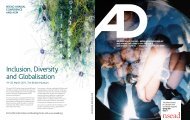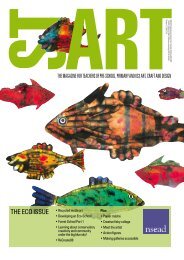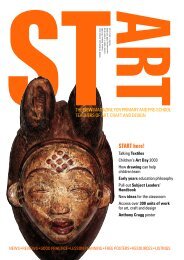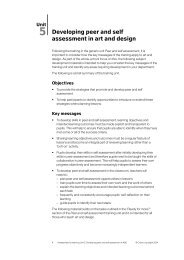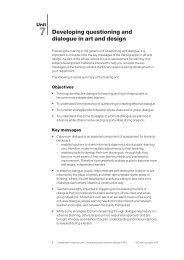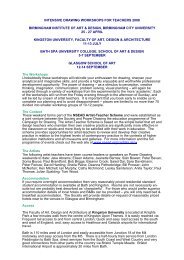Research in Visual Arts Education - Bilderlernen.at
Research in Visual Arts Education - Bilderlernen.at
Research in Visual Arts Education - Bilderlernen.at
Create successful ePaper yourself
Turn your PDF publications into a flip-book with our unique Google optimized e-Paper software.
MEDIATED ACTION AND AESTHETIC LEARNINGIn Denmark, “child art” was never abandoned as a topic of study. Instead,established accounts of children’s appropri<strong>at</strong>ion of a pictorial languagewere revised. Soon after, but <strong>in</strong>dependent of, the public<strong>at</strong>ion of Brent andMarjorie Wilson’s “Iconoclastic view of the imagery sources <strong>in</strong> the draw<strong>in</strong>gsof young people” (1977), the Danish art educ<strong>at</strong>ors Rolf Köhler and KristianPedersen (1978) published a book where they criticized the famous ViktorLowenfeld (Lowenfeld & Britta<strong>in</strong>, 1969) for not tak<strong>in</strong>g <strong>in</strong>to consider<strong>at</strong>ionthe gre<strong>at</strong> impact of the visual culture <strong>in</strong> which children particip<strong>at</strong>e. Likethe article by the Wilsons, their book cre<strong>at</strong>ed a huge stir among those whocherished the romantic view of the <strong>in</strong>nocent child.In the Nordic countries, Lowenfeld’s grand narr<strong>at</strong>ive of the emancip<strong>at</strong>ionof the child from artful scribbles, via a grow<strong>in</strong>g mastery of visual realismto the expressive qualities of early Modernism, is giv<strong>in</strong>g way to a variety ofsmaller, less comprehensive narr<strong>at</strong>ives. The copies sold of the Danish transl<strong>at</strong>ion(1 st ed. 1971; 2 nd ed. 1976) of Cre<strong>at</strong>ive and mental growth <strong>in</strong> Scand<strong>in</strong>avia,decl<strong>in</strong>ed from around 1,200 <strong>in</strong> 1984 to less than 300 <strong>in</strong> 1995/1996. Today,artistic development is r<strong>at</strong>her described as the growth of a gradually more differenti<strong>at</strong>edrepertoire, with different options co-exist<strong>in</strong>g and be<strong>in</strong>g availablefor different purposes, r<strong>at</strong>her than replac<strong>in</strong>g each other <strong>in</strong> a hierarchical order.Process and socio-cultural approaches laid the found<strong>at</strong>ion for a revivalof <strong>in</strong>terest <strong>in</strong> children’s draw<strong>in</strong>gs <strong>in</strong> the 1990s (e.g. Hansson et al., 1991;Andersson, 1994; L<strong>in</strong>dström, 1995; Aronsson & Andersson 1996; Aronsson,1997). For example, Kar<strong>in</strong> Aronsson & Sven Andersson (1996; Andersson,1994) asked African and Swedish children to make draw<strong>in</strong>gs of classroomlife and of their future family. Their f<strong>in</strong>d<strong>in</strong>gs supported the notion of “socialscal<strong>in</strong>g”; th<strong>at</strong> is, social space <strong>in</strong> the draw<strong>in</strong>gs (rel<strong>at</strong>ive size, distances, degreeof detail<strong>in</strong>g etc.) reflected children’s hierarchies of importance.Another mani fest<strong>at</strong>ion of the child art revival is The cultural context(L<strong>in</strong>dström, 2000), present<strong>in</strong>g papers from a symposium held <strong>in</strong> Vilnius,Lithuania, which was organized by the Network of Nordic <strong>Research</strong>ers<strong>in</strong> <strong>Visual</strong> <strong>Arts</strong> <strong>Educ<strong>at</strong>ion</strong>. In this edited volume, Aronsson & Junge andL<strong>in</strong>dström, for example, presented cultural com par<strong>at</strong>ive studies of children’sdraw<strong>in</strong>gs <strong>in</strong> non-European cultures, such as Ethiopia, Nepal, Mongolia andCuba.Marie Bendroth Karlsson (1996) studied visual arts projects <strong>in</strong> theSwedish preschool and school. She concluded th<strong>at</strong> “art activities are oftenmade subord<strong>in</strong><strong>at</strong>e to other goals and used as means for reach<strong>in</strong>g non-artisticgoals, such as diagnostics, decor<strong>at</strong>ion/enterta<strong>in</strong>ment, concept learn<strong>in</strong>getc.” (p. 300). Elisabet Ahlner Malmström (1998) analysed communic<strong>at</strong>ive54 NORDIC VISUAL ARTS EDUCATION IN TRANSITION




